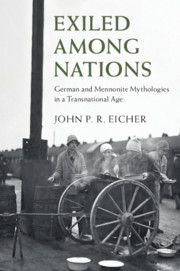Book contents
- Exiled Among Nations
- Publications of the German Historical Institute
- Exiled Among Nations
- Copyright page
- Dedication
- Contents
- Figures
- Maps
- Acknowledgments
- Abbreviations
- Introduction
- 1 No Lasting City (1870–1930)
- 2 A Sort of Homecoming (1929–1931)
- 3 Troubled Tribes in the Promised Land (1930–1939)
- 4 Mennonite (Di)Visions (1930–1939)
- 5 Peanuts for the Führer (1933–1939)
- 6 Centrifugal Fantasies, Centripetal Realities (1939–1945)
- Conclusion
- Bibliography
- Index
4 - Mennonite (Di)Visions (1930–1939)
Published online by Cambridge University Press: 01 December 2019
- Exiled Among Nations
- Publications of the German Historical Institute
- Exiled Among Nations
- Copyright page
- Dedication
- Contents
- Figures
- Maps
- Acknowledgments
- Abbreviations
- Introduction
- 1 No Lasting City (1870–1930)
- 2 A Sort of Homecoming (1929–1931)
- 3 Troubled Tribes in the Promised Land (1930–1939)
- 4 Mennonite (Di)Visions (1930–1939)
- 5 Peanuts for the Führer (1933–1939)
- 6 Centrifugal Fantasies, Centripetal Realities (1939–1945)
- Conclusion
- Bibliography
- Index
Summary
Chapter 4 looks abroad – to Canada, Germany, and the United States – to examine how the Mennonite colonies found themselves in the crosshairs of a range of competing Mennonite nationalist narratives. In particular, the chapter focuses on the US-based aid organization the Mennonite Central Committee (MCC), which helped relocate the Fernheim colonists from Germany to Paraguay. The MCC viewed the colonies as an opportunity to create a Mennonite territory that was theologically and organizationally connected to a global Mennonite confession. In its evolving idea of “Mennoniteness,” the basis of this linkage involved Mennonites sharing a few, definitive tenets – such as mutual aid and nonviolence – that could be historically justified and concisely articulated to non–Mennonites. Yet there were competing interpretations of the “Mennonite nation.” Mennonite intellectuals in Germany and Canada advanced notions that Mennonites should fuse their narrative with a German nationalist narrative. Yet Paraguay’s Mennonite colonists also elicited the fear that far-scattered Mennonites would lose their Mennonite or German-Mennonite heritage or refuse to join a Mennonite or German–Mennonite nation. The term “Mennonite,” as this chapter demonstrates, represented more than a religious confession during the interwar years, but stood alongside other nascent nationalisms vying to win the loyalties of an often–indifferent constituency.
Keywords
- Type
- Chapter
- Information
- Exiled Among NationsGerman and Mennonite Mythologies in a Transnational Age, pp. 167 - 205Publisher: Cambridge University PressPrint publication year: 2020

